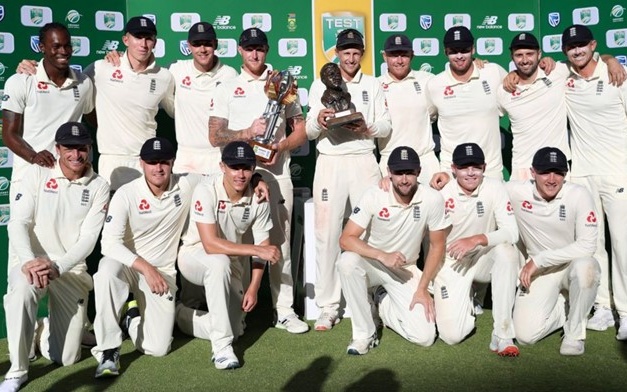England Test cricket team in Johannesburg, South Africa, January 2020 — 7 of the 11 were privately educated
Asked about the state of inclusion within English cricket earlier this month, current England one-day captain Eoin Morgan hailed progress, “The diversity of England’s World Cup-winning squad had not only showed the value of embracing different cultures but, in his opinion, it offered a fairer reflection of the current status of English cricket.”
But Morgan also admitted that the England and Wales Cricket Board must go much farther to foster an inclusive culture.
He was right to do so. His statement was prompted by a question about all-rounder Azeem Rafiq’s claims of institutional racism at the Yorkshire county club. Last month, a young Muslim player, Feroze Khushi, was showered with alcohol as Essex celebrated their county tournament win.
And a recent investigation found that there are just 33 players from ethnic minorities in county cricket.
The Dominance of Private Schools
English cricket has a race issue. It has a class issue. And it has both, for class and race are intertwined.
In January, the official England Cricket account posted a photograph with the caption “The future looks very bright”. The image was of five of England’s newest and most promising stars in the changing rooms after defeating South Africa in Johannesburg: Dominic Sibley, Zak Crawley, Dominic Bess, Samuel Curran, and Oliver Pope. All were awarded Test match central contracts last month.
All are immensely talented individuals who have put in thousands of hours of intense commitment and sacrifice. Each is also the beneficiary of a private education.
Morgan may have cited progress, but the make-up of England’s Test Cricket team testifies to an overwhelming dependence on those fortunate enough to afford an independent education. Two-thirds of England cricketers with contracts for the forthcoming Test year have a private school background.
Ben Stokes, hero of the 2019 World Cup and winner of BBC Sports Personality of the Year, highlighted the capacity of cricket to still captivate a nation and its people. But Stokes, working-class and state-school educated, is one of just four contracted Test cricketers who are outside the independent school system, alongside James Anderson, Jofra Archer, and Chris Woakes. That is a sharp contrast with England from 1960 to 1990, when at least 60% of cricketers on each team were from state schools.
Only 7% of the English population is privately educated, but 43% of men and 35% of women playing international cricket for England attended private school. In contrast, just 5% of England football internationals received an independent education.
A Lack of Opportunity
The dependence of English cricket on private schools is alarming for a sport which is making increasing efforts to broaden its appeal. The game of today is inaccessible to many, both in participation and in a widening disconnect between the general public and the national teams. The composition of the current English cricket team reflects the stark impact of differing school cultures and access to high-quality sporting facilities.
Private schools are not the problem. These institutions produce an influx of international talent on the foundation of excellent coaching and infrastructure of the highest caliber. Schools like Whitgift and Millfield are renowned for creating an environment ripe for sporting success, with the scheduling of regular fixtures and access to individual coaching.
Instead, it is the lack of opportunity at state schools that must be addressed. As Laura Cordingley, chief executive at the national cricket charity Chance to Shine, notes, youngsters need to see players from backgrounds like their own. Some international players, like Joe Root, have moved from state to private schools after receiving sports scholarships. However, such scholarships are far and few in between.
Amar Virdi, a British Asian on the verge of making his England debut, has noted how there is cricket on a weekly basis at private schools, but some state schools might not even play it. Simon Hughes, the veteran cricketing journalist, has observed that only 12% of secondary school children had the chance to play cricket during the school summer.
To improve social mobility across cricket, there must also be an emphasis on improving the standard of physical education within the state sector. Without facilities and without the recognition of sport as an important part of the timetable, the avenues to nurture potential are limited.
How to Inspire?
The ECB’s “Inspiring Generations” strategy claims the aim of connecting communities. But how exactly can you ensure a new generation to say, “Cricket is a game for me”, when youth cannot associate their stories with those that represent their country? How can the appeal of the game be broadened when there is a lack of access?
The summer of 2019 showed that cricket could be a sport for the many and not for the few. England’s World Cup heroics highlighted the immense appeal that cricket can still wield, as 8 million British spectators tuned in to watch the final.
But for that moment to be more than fleeting, the invisible boundaries that exist need to be removed — be this through forging links between those at different levels of the game or through making cricket a mandatory part of the curriculum.
Talent and potential will always be essential factors in a cricketer’s future. Those cannot be instilled. However, by shifting the variable of class and schooling, they can be nurtured — not just for the sake of the game, but for the game within a changing English society.

